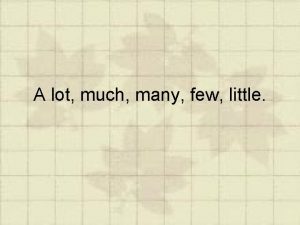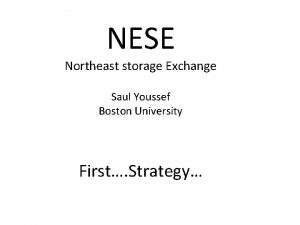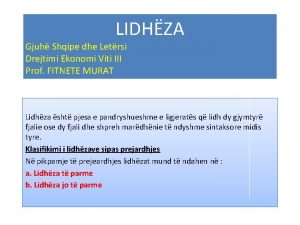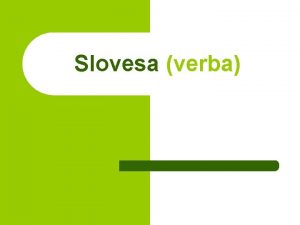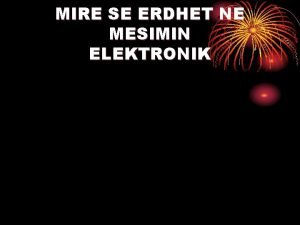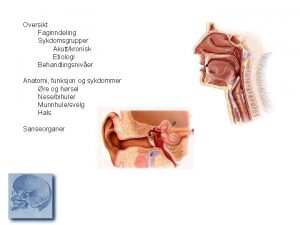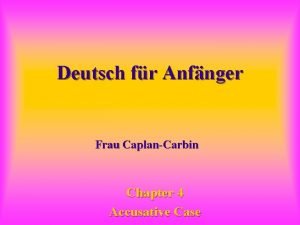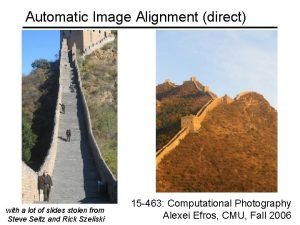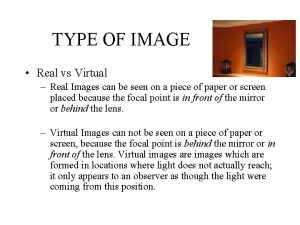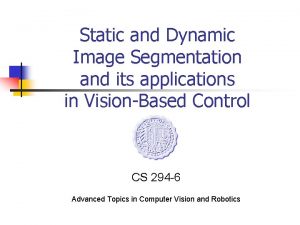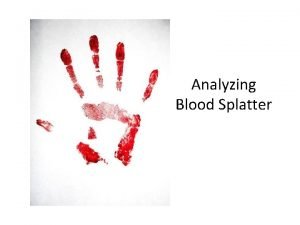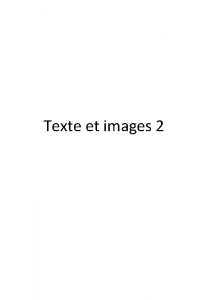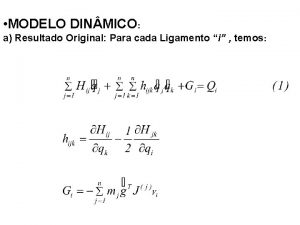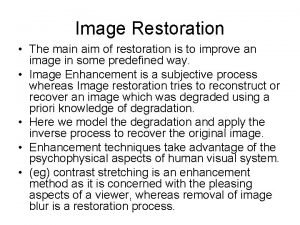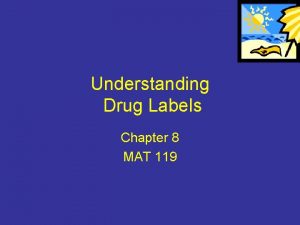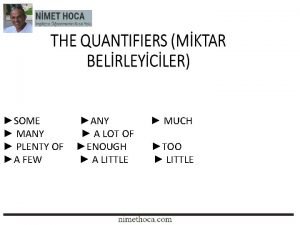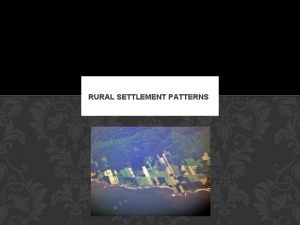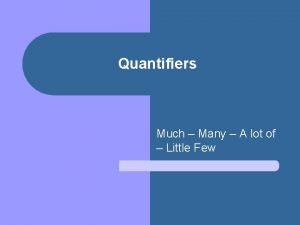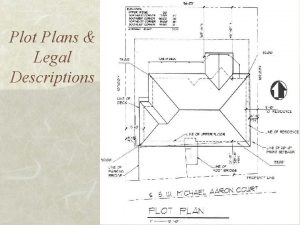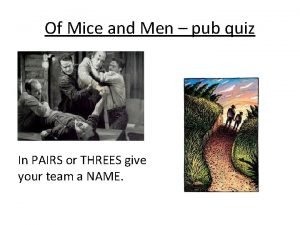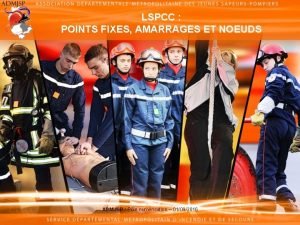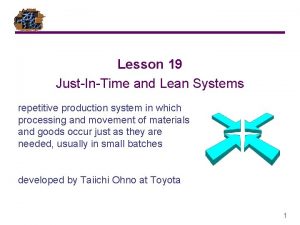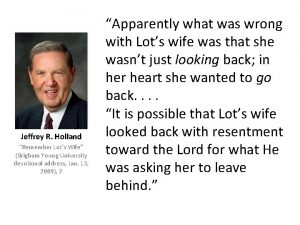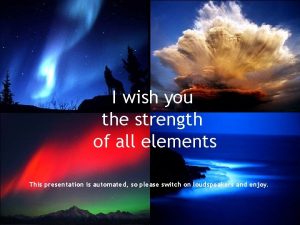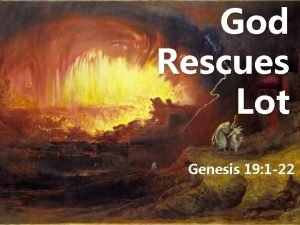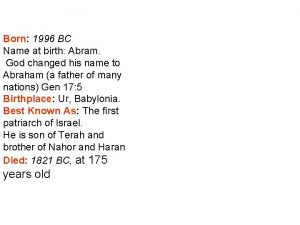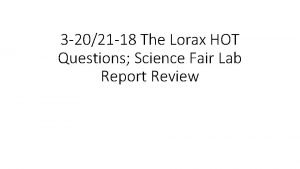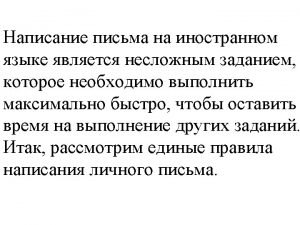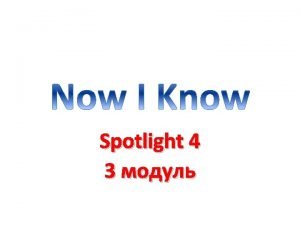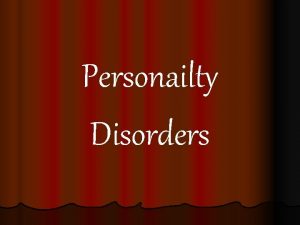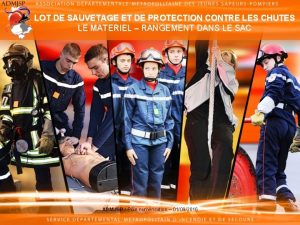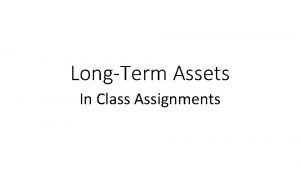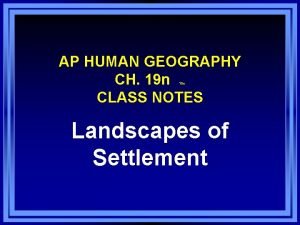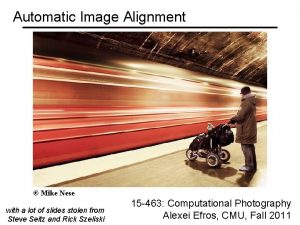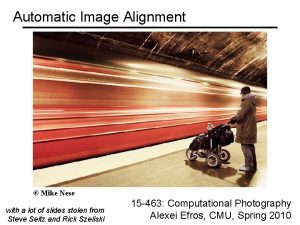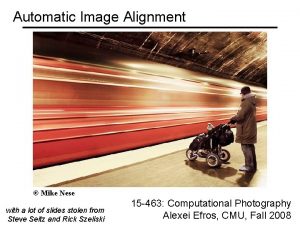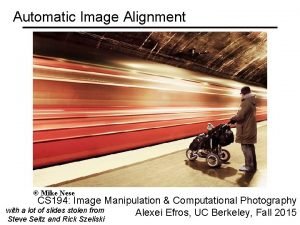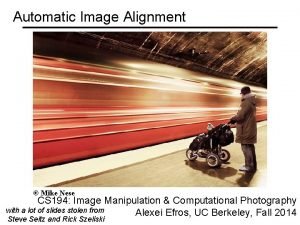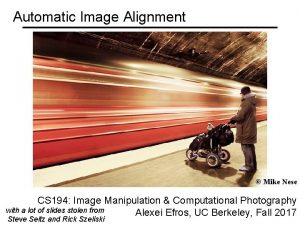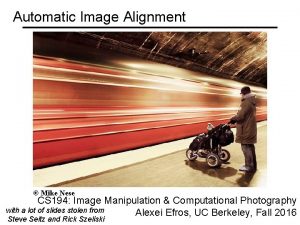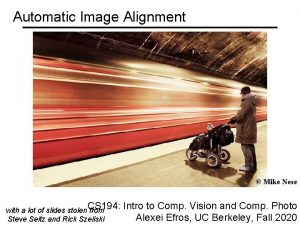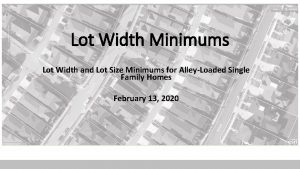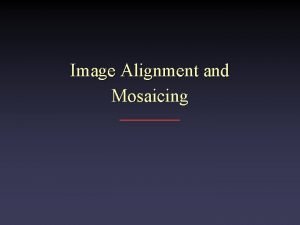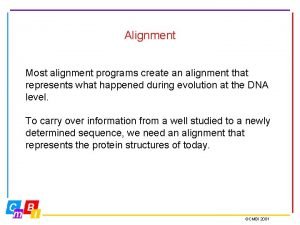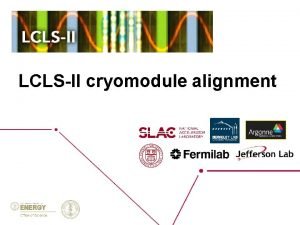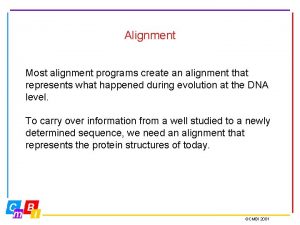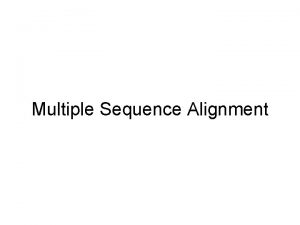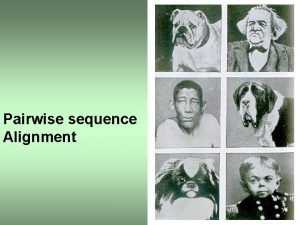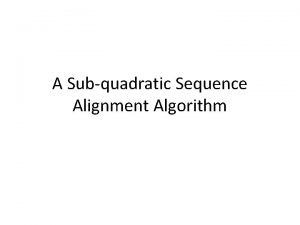Automatic Image Alignment Mike Nese with a lot

















![Harris Detector: Mathematics Change of intensity for the shift [u, v]: Window function Shifted Harris Detector: Mathematics Change of intensity for the shift [u, v]: Window function Shifted](https://slidetodoc.com/presentation_image_h2/9210c02531987f783369d7c4defc93fe/image-18.jpg)
![Harris Detector: Mathematics For small shifts [u, v] we have a bilinear approximation: where Harris Detector: Mathematics For small shifts [u, v] we have a bilinear approximation: where](https://slidetodoc.com/presentation_image_h2/9210c02531987f783369d7c4defc93fe/image-19.jpg)

























![Feature-space outlier rejection A better way [Lowe, 1999]: • • 1 -NN: SSD of Feature-space outlier rejection A better way [Lowe, 1999]: • • 1 -NN: SSD of](https://slidetodoc.com/presentation_image_h2/9210c02531987f783369d7c4defc93fe/image-45.jpg)






























- Slides: 75

Automatic Image Alignment © Mike Nese with a lot of slides stolen from Steve Seitz and Rick Szeliski 15 -463: Computational Photography Alexei Efros, CMU, Fall 2012

Live Homography DEMO Check out panoramio. com “Look Around” feature! Also see Open. Photo VR: http: //openphotovr. org/

Image Alignment How do we align two images automatically? Two broad approaches: • Feature-based alignment – Find a few matching features in both images – compute alignment • Direct (pixel-based) alignment – Search for alignment where most pixels agree

Direct Alignment The simplest approach is a brute force search (hw 1) • Need to define image matching function – SSD, Normalized Correlation, edge matching, etc. • Search over all parameters within a reasonable range: e. g. for translation: for tx=x 0: step: x 1, for ty=y 0: step: y 1, compare image 1(x, y) to image 2(x+tx, y+ty) end; Need to pick correct x 0, x 1 and step • What happens if step is too large?

Direct Alignment (brute force) What if we want to search for more complicated transformation, e. g. homography? for a=a 0: astep: a 1, for b=b 0: bstep: b 1, for c=c 0: cstep: c 1, for d=d 0: dstep: d 1, for e=e 0: estep: e 1, for f=f 0: fstep: f 1, for g=g 0: gstep: g 1, for h=h 0: hstep: h 1, compare image 1 to H(image 2) end; end;

Problems with brute force Not realistic • Search in O(N 8) is problematic • Not clear how to set starting/stopping value and step What can we do? • Use pyramid search to limit starting/stopping/step values • For special cases (rotational panoramas), can reduce search slightly to O(N 4): – H = K 1 R 1 R 2 -1 K 2 -1 (4 DOF: f and rotation) Alternative: gradient decent on the error function • i. e. how do I tweak my current estimate to make the SSD error go down? • Can do sub-pixel accuracy • BIG assumption? – Images are already almost aligned (<2 pixels difference!) – Can improve with pyramid • Same tool as in motion estimation

Image alignment

Feature-based alignment 1. Find a few important features (aka Interest Points) 2. Match them across two images 3. Compute image transformation as per Project #5 Part I How do we choose good features? • • They must be prominant in both images Easy to localize Think how you did that by hand in Project #5 Part I Corners!

Feature Detection

Feature Matching How do we match the features between the images? • Need a way to describe a region around each feature – e. g. image patch around each feature • Use successful matches to estimate homography – Need to do something to get rid of outliers Issues: • What if the image patches for several interest points look similar? – Make patch size bigger • What if the image patches for the same feature look different due to scale, rotation, etc. – Need an invariant descriptor

Invariant Feature Descriptors Schmid & Mohr 1997, Lowe 1999, Baumberg 2000, Tuytelaars & Van Gool 2000, Mikolajczyk & Schmid 2001, Brown & Lowe 2002, Matas et. al. 2002, Schaffalitzky & Zisserman 2002

Today’s lecture • 1 Feature detector • scale invariant Harris corners • 1 Feature descriptor • patches, oriented patches Reading: Multi-image Matching using Multi-scale image patches, CVPR 2005

Invariant Local Features Image content is transformed into local feature coordinates that are invariant to translation, rotation, scale, and other imaging parameters Features Descriptors

Applications Feature points are used for: • Image alignment (homography, fundamental matrix) • 3 D reconstruction • Motion tracking • Object recognition • Indexing and database retrieval • Robot navigation • … other

Harris corner detector C. Harris, M. Stephens. “A Combined Corner and Edge Detector”. 1988

The Basic Idea We should easily recognize the point by looking through a small window Shifting a window in any direction should give a large change in intensity

Harris Detector: Basic Idea “flat” region: no change in all directions “edge”: no change along the edge direction “corner”: significant change in all directions
![Harris Detector Mathematics Change of intensity for the shift u v Window function Shifted Harris Detector: Mathematics Change of intensity for the shift [u, v]: Window function Shifted](https://slidetodoc.com/presentation_image_h2/9210c02531987f783369d7c4defc93fe/image-18.jpg)
Harris Detector: Mathematics Change of intensity for the shift [u, v]: Window function Shifted intensity Window function w(x, y) = Intensity or 1 in window, 0 outside Gaussian
![Harris Detector Mathematics For small shifts u v we have a bilinear approximation where Harris Detector: Mathematics For small shifts [u, v] we have a bilinear approximation: where](https://slidetodoc.com/presentation_image_h2/9210c02531987f783369d7c4defc93fe/image-19.jpg)
Harris Detector: Mathematics For small shifts [u, v] we have a bilinear approximation: where M is a 2 2 matrix computed from image derivatives:

Harris Detector: Mathematics Classification of image points using eigenvalues of M: 2 “Edge” 2 >> 1 “Corner” 1 and 2 are large, 1 ~ 2; E increases in all directions 1 and 2 are small; E is almost constant in all directions “Flat” region “Edge” 1 >> 2 1

Harris Detector: Mathematics Measure of corner response:

Harris Detector The Algorithm: • Find points with large corner response function R (R > threshold) • Take the points of local maxima of R

Harris Detector: Workflow

Harris Detector: Workflow Compute corner response R

Harris Detector: Workflow Find points with large corner response: R>threshold

Harris Detector: Workflow Take only the points of local maxima of R

Harris Detector: Workflow

Harris Detector: Some Properties Rotation invariance Ellipse rotates but its shape (i. e. eigenvalues) remains the same Corner response R is invariant to image rotation

Harris Detector: Some Properties Partial invariance to affine intensity change ü Only derivatives are used => invariance to intensity shift I I + b ü Intensity scale: I a I R R threshold x (image coordinate)

Harris Detector: Some Properties But: non-invariant to image scale! All points will be classified as edges Corner !

Scale Invariant Detection Consider regions (e. g. circles) of different sizes around a point Regions of corresponding sizes will look the same in both images

Scale Invariant Detection The problem: how do we choose corresponding circles independently in each image? Choose the scale of the “best” corner

Feature selection Distribute points evenly over the image

Adaptive Non-maximal Suppression Desired: Fixed # of features per image • Want evenly distributed spatially… • Sort points by non-maximal suppression radius [Brown, Szeliski, Winder, CVPR’ 05]

Feature descriptors We know how to detect points Next question: How to match them? ? Point descriptor should be: 1. Invariant 2. Distinctive

Descriptors Invariant to Rotation Find local orientation Dominant direction of gradient • Extract image patches relative to this orientation

Multi-Scale Oriented Patches Interest points • Multi-scale Harris corners • Orientation from blurred gradient • Geometrically invariant to rotation Descriptor vector • Bias/gain normalized sampling of local patch (8 x 8) • Photometrically invariant to affine changes in intensity [Brown, Szeliski, Winder, CVPR’ 2005]

Descriptor Vector Orientation = blurred gradient Rotation Invariant Frame • Scale-space position (x, y, s) + orientation ( )

Detections at multiple scales

MOPS descriptor vector 8 x 8 oriented patch • Sampled at 5 x scale Bias/gain normalisation: I’ = (I – )/ 40 pi xels 8 pixels

Feature matching ?

Feature matching • Exhaustive search • for each feature in one image, look at all the other features in the other image(s) • Hashing • compute a short descriptor from each feature vector, or hash longer descriptors (randomly) • Fast Nearest neighbor techniques • kd-trees and their variants

What about outliers? ?

Feature-space outlier rejection Let’s not match all features, but only these that have “similar enough” matches? How can we do it? • SSD(patch 1, patch 2) < threshold • How to set threshold?
![Featurespace outlier rejection A better way Lowe 1999 1 NN SSD of Feature-space outlier rejection A better way [Lowe, 1999]: • • 1 -NN: SSD of](https://slidetodoc.com/presentation_image_h2/9210c02531987f783369d7c4defc93fe/image-45.jpg)
Feature-space outlier rejection A better way [Lowe, 1999]: • • 1 -NN: SSD of the closest match 2 -NN: SSD of the second-closest match Look at how much better 1 -NN is than 2 -NN, e. g. 1 -NN/2 -NN That is, is our best match so much better than the rest?

Feature-space outliner rejection Can we now compute H from the blue points? • No! Still too many outliers… • What can we do?

Matching features What do we do about the “bad” matches?

RAndom SAmple Consensus Select one match, count inliers

RAndom SAmple Consensus Select one match, count inliers

Least squares fit Find “average” translation vector

RANSAC for estimating homography RANSAC loop: 1. Select four feature pairs (at random) 2. Compute homography H (exact) 3. Compute inliers where SSD(pi’, H pi) < ε 4. Keep largest set of inliers 5. Re-compute least-squares H estimate on all of the inliers

RANSAC

Example: Recognising Panoramas M. Brown and D. Lowe, University of British Columbia

Why “Recognising Panoramas”?

Why “Recognising Panoramas”? 1 D Rotations ( ) • Ordering matching images

Why “Recognising Panoramas”? 1 D Rotations ( ) • Ordering matching images

Why “Recognising Panoramas”? 1 D Rotations ( ) • Ordering matching images

Why “Recognising Panoramas”? 1 D Rotations ( ) • Ordering matching images • 2 D Rotations ( , f) – Ordering matching images

Why “Recognising Panoramas”? 1 D Rotations ( ) • Ordering matching images • 2 D Rotations ( , f) – Ordering matching images

Why “Recognising Panoramas”? 1 D Rotations ( ) • Ordering matching images • 2 D Rotations ( , f) – Ordering matching images

Why “Recognising Panoramas”?

Overview Feature Matching Image Matching Bundle Adjustment Multi-band Blending Results Conclusions

RANSAC for Homography

RANSAC for Homography

RANSAC for Homography

Probabilistic model for verification

Finding the panoramas

Finding the panoramas

Finding the panoramas

Finding the panoramas

Homography for Rotation Parameterise each camera by rotation and focal length This gives pairwise homographies

Bundle Adjustment New images initialised with rotation, focal length of best matching image

Bundle Adjustment New images initialised with rotation, focal length of best matching image

Multi-band Blending Burt & Adelson 1983 • Blend frequency bands over range

Results
 How much is in a lot
How much is in a lot Beer is countable or uncountable
Beer is countable or uncountable The lot-for-lot (lfl) rule
The lot-for-lot (lfl) rule Global alignment vs local alignment
Global alignment vs local alignment Pam1250
Pam1250 Sequence alignment
Sequence alignment Local alignment in bioinformatics
Local alignment in bioinformatics Jonathan pevsner
Jonathan pevsner Vzory sloves
Vzory sloves Nese boston
Nese boston Lidhezat
Lidhezat Nese do te mbjellesh per nje vit
Nese do te mbjellesh per nje vit Nese bere maže peče umře
Nese bere maže peče umře Llojet e pasqyrimit
Llojet e pasqyrimit Bihuler
Bihuler Skill samurai windsor
Skill samurai windsor Rese nese
Rese nese Portrait matting
Portrait matting Image alignment and stitching
Image alignment and stitching Direct image alignment
Direct image alignment Constructive alignment model
Constructive alignment model Real vs virtual
Real vs virtual Virtual and real images
Virtual and real images Translate
Translate Optimum notch filter in digital image processing
Optimum notch filter in digital image processing Image compression in digital image processing
Image compression in digital image processing Key stage in digital image processing
Key stage in digital image processing Analog image and digital image
Analog image and digital image Error free compression
Error free compression Image sharpening in digital image processing
Image sharpening in digital image processing Static image vs dynamic
Static image vs dynamic Geometric transformation in digital image processing
Geometric transformation in digital image processing Gravitational blood drop
Gravitational blood drop Fundamental steps in digital image processing
Fundamental steps in digital image processing Ce n'est pas une image juste c'est juste une image
Ce n'est pas une image juste c'est juste une image Difference between logical file and physical file
Difference between logical file and physical file Qual o resultado de: image image
Qual o resultado de: image image Enlighten about image noise and restoration
Enlighten about image noise and restoration Digital image processing
Digital image processing Image geometry in digital image processing
Image geometry in digital image processing Image restoration in digital image processing
Image restoration in digital image processing Xuite blog
Xuite blog Generative adversarial networks
Generative adversarial networks Parts of a drug label
Parts of a drug label A lot of hangi cümlelerde kullanılır
A lot of hangi cümlelerde kullanılır Concession system of southern ontario
Concession system of southern ontario Fill in many much (x2) few little a lot of
Fill in many much (x2) few little a lot of Metes and bounds system example
Metes and bounds system example Curley's like a lot of little guys
Curley's like a lot of little guys Lot of countable or uncountable
Lot of countable or uncountable Paniczny lęk frazeologizm
Paniczny lęk frazeologizm A lot of / lots of
A lot of / lots of Point d'amarrage lspcc
Point d'amarrage lspcc Small lot production
Small lot production Elder holland lot's wife
Elder holland lot's wife Wish you lots of strength
Wish you lots of strength Lot rescued by angels
Lot rescued by angels Some many any much
Some many any much In the lean philosophy, the ideal lot size is:
In the lean philosophy, the ideal lot size is: Managing economies of scale in a supply chain
Managing economies of scale in a supply chain Noah and abraham family tree
Noah and abraham family tree So be your name buxbaum
So be your name buxbaum Assumption of liability form for strata
Assumption of liability form for strata Alot vs alot
Alot vs alot The lorax hot
The lorax hot Drp distribution resource planning
Drp distribution resource planning Dear john last letter
Dear john last letter Look, read and choose the correct sentence
Look, read and choose the correct sentence A lot preposition
A lot preposition Personality disorder types
Personality disorder types Saturn.lot.pl
Saturn.lot.pl Lot de sauvetage
Lot de sauvetage Diaz company owns a milling machine that cost
Diaz company owns a milling machine that cost Major scale whole and half steps
Major scale whole and half steps Long lot definition ap human geography
Long lot definition ap human geography Iot system design methodology steps
Iot system design methodology steps
